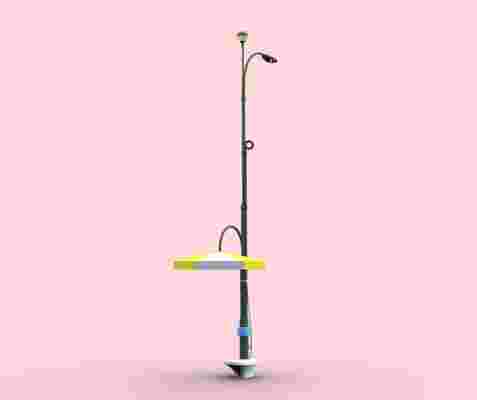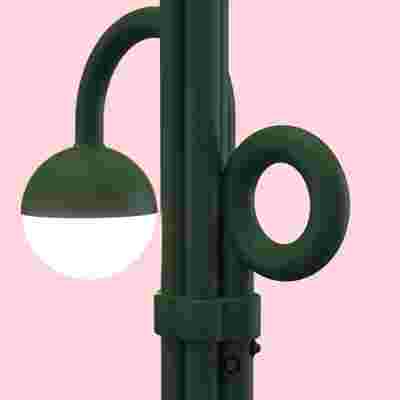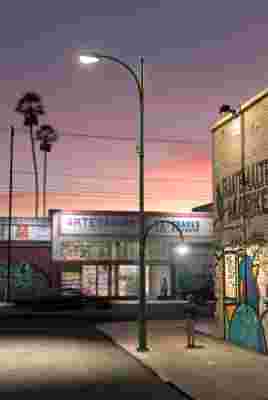Los Angeles's New Streetlights Will Do A Lot More Than Provide Light
While streetlights may go unnoticed in most towns, Los Angeles is a city that cares about them. (Look no further than Chris Burden’s iconic Urban Light installation outside of LACMA , featuring 202 historic lights, for proof.) There are currently more than 223,000 in operation, representing over 400 styles, including ornate historic lights such as the Five Globe Llewellyn and the Broadway Electrolier. But L.A.’s current standard streetlight is utilitarian and inflexible—not the aesthetic the home of Hollywood wants, especially as the city gears up to host the Olympics in 2028. In November of 2019 the city announced L.A. Lights the Way, a design competition to create a new streetlight for Los Angeles, and now the winning design, Superbloom, has been revealed.
Superbloom is the creation of L.A.-based design studio Project Room. The design team dreamed up a playful streetlight that could accommodate the current requirements, and adapt to future needs. The design features a cluster of aluminum tubes, each of which accommodates a different function, such as pedestrian-side lights or telecommunications equipment. “Instead of thinking of [a streetlight] as one pole as it is traditionally used today, it's a bundle of poles,” says project leader Sandy Yum. “The analogy we keep using is it’s like a bouquet of flowers.”

The new streetlight design allows for a variety of additions, such as shade fixtures, charging stations, or a bench.
“The idea of the bundle was to give it a strong profile and form a while answering all these needs of the city,” says design lead Joakim Dahlqvist. “We found it was a really strong response as an aesthetic silhouette but also a functional system, almost like a kind of a multiplug that can organize and separate systems.” Additional components can be added, such as EV chargers, 5G infrastructure, shade fixtures, or a bench, giving the city flexibility to update the overall design, or individual streetlights, without starting from scratch. “The number of tubes basically provides the amount of flexibility per light,” says technical lead Sumit Sahdev. “We've left the number open-ended. It’s just kind of temporarily plugged and then as there's a need for additional things in the future, those posts can be uncapped and the arm can just be dropped in in a very simple installation process as well.”
The clear delineation of components also gives the lights a sense of functional transparency. “The impetus in a way was also just to have a certain level of honesty about the different functions that the poles can take on,” says Isaac Resnikoff, Project Room founder. Sahdev notes that this honesty is even more critical as the country re-examines the invisible structures that surround us. So rather than a monolithic pole that conceals its contents and uses, the Superbloom allows citizens to understand what is standing on their street.

The streetlight design, which was inspired by a bouquet of flowers, allows for more future additions should the street or area require them.
One of the city’s priorities was adding a pedestrian fixture to illuminate the sidewalk or pedestrian pathway, which could enhance public safety. “Adding a pedestrian fixture to the light is something that we're really excited about and I think will be a huge transformation for the cityscape and the urban environment,” says Dahlqvist. “The old streetlights in L.A., the kind of classic lanterns, they're at the height that we're now setting our pedestrian lights.” The team was conscious of the potential for light pollution with the addition of the second fixture. Yum notes that they wanted to add to the atmosphere of the streetscape while also maintaining the dark sky.
The design incorporates shade fixtures, which the city hopes will help residents cope with the impacts of climate change, and will use LED lights. L.A. streetlights have been using LEDs since 2009, and while there has been controversy in some cities over the change in light created by LED versus older sodium lights, which give a warmer glow, the designers note that the latest generations of LEDs offer improvements in temperature and glare.

A rendering shows what the new streetlight design would look like at dusk in the city.
They chose a green hue for the structure, which Dahlqvist says has a touch of nostalgia to it. The city’s current gray standard streetlights blend with the sidewalk and contrast with the vegetation, so the team decided to do the opposite. “We think it will be a more visible element as you're walking in the streets and maybe also kind of less visible in the streetscape,” Dahlqvist says.
Now that Superbloom has been chosen, Project Room will work with the city to finesse and optimize the design, then prototypes will be made as part of a public bidding process. The lights will be tested on a whole street before gradually being rolled out as the city replaces standard streetlights. While it will be several years before the lights begin to make their mark on the cityscape, there’s certainly a good chance that Superbloom will become another one of Los Angeles’s iconic streetlights.